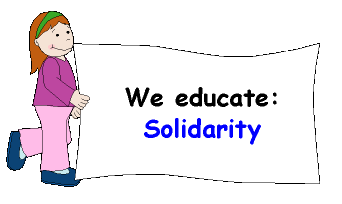|
Solidarity is a personal value, which expresses the purest manifestations of men and women as social beings. In a collectively or social group, solidarity is the capacity of performing as a whole in a group. It is a term that denotes a high degree of integration and internal stability; it is the limitless and total adhesion to a cause, situation or circumstance, which implies to assume and to share the benefits and the risks. The notion of solidarity is against the conception of man’s nature based on hostility and competition; for that reason it is indispensable that it is contemplated in the development of the child as a future man of peace. It is a bond that unites men and countries so that the well-being of some determines the wellbeing of the others. A supportive man or woman is the one who is tied or united with others by communal interests and responsibilities. In pre-school we can set up the premises for the development of solidarity, and for this it is necessary to teach the children to their mates in difficult times, to feel happiness with the successes of others and sadness for the problems that happen to their mates. Moreover, we can teach them to be sensitive towards the youngest and the elderly, and that in other parts of the world there are children, men and women that need our help, that countries should help each other to be able to live peacefully. |
ACTIVITY
No 1 |
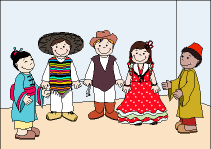 |
Summary of the activity: In this activity we will observe photos, pictures, or other materials that reflect the customs, clothes, language of other boys and girls of the world, particularly those from where some of the children may come from. A video projection with dances or any other topic referred to the way of life in other countries will be shown, and there will be a workshop where the children will draw, cut out and paste clothes, accessories and representative objects from several countries. Finally there will be a festival where the boys and girls will recite poems, tell stories and perform dances from other countries with typical dresses and in which the parents will participate. Objectives: To develop in the children knowledge about the culture, the work, the customs and the way of life of people from different countries. Procedures:
Material Resources: Videotape or a compact disc (CD), photos, pictures, scissors, glue, stickers and materials that serve to decorate the classroom (little flags, color paper), the national flag and flags from other countries. Typical dresses from other cultures, songs, handcrafted objects that reflect the customs and idiosyncrasy of other towns of the world; as well as items produced in other countries and that are used in our country. We also need sound and video equipments or a computer.
Development of the activity: The
educator can select the material about other countries, taking into
account the following aspects:
2nd Part It is also important to talk with the boys and girls about the things or items of personal use, or the household things, or the things of social use in the community, also the things to eat that are consumed in our country and that come from these countries, in order to reach the conclusion that other people work a lot so that we can have or consume those products.
3rd Part
4th Part |
CRITERIAL
ASSESSMENT |
|||
Observed
conduct |
YES |
NO |
Comments |
They
gave their opinions on what was observed about the life of other countries
in the world. |
|||
They
have expressed appreciation of the culture, way of life, etc. of other
countries of the world. |
|||
They
showed interest in learning more about what they have observed and listened
to about people and children from other cultures. |
|||
They
showed a desire to cooperate with the children or people from those
places. |
|||
ACTIVITY
No 2 |
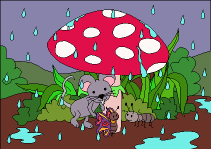 |
Summary of the activity: The boys and girls will dramatize the story "Under a mushroom", first they will learn the story, later they will dramatize it and later they will talk about the dramatized facts. The teacher can adapt the story for this dramatization and change the number of characters or the type of animals to be portrayed, although all the animals must be small. Objectives: To develop in the children feelings of solidarity towards other people. Procedures:
Material Resources: Color papers, watercolors, brushes, temperas, fine cardboard, glue and all the necessary things to make the decoration of the stage. Costumes for the different little animals from the story (ant, mouse, butterfly, etc.).
Development of the activity: The story will be read to the children who are going to act it as many times as it is necessary for them to know it perfectly and learn well the character that they are going to dramatize, which has been identified by each one. The educator will try to dress up the children with the typical elements of their characters (antennas, paper wings, etc.).
2nd Part
3rd Part Before beginning the dramatization the educator will explain to the audience what they are going to see, and tell them that they must pay a lot of attention because later they will have to answer questions on what they have seen and listened. The educator will tell the story:
4th Part The educator will help the children who need it with support questions so that they are able to express their ideas about the subject. The activity will be concluded giving the children the possibility to talk about some supportive attitudes of their little mates, friends, neighbours, relatives, etc. |
CRITERIAL
ASSESSMENT |
|||
Observed
conduct |
YES |
NO |
Comments |
They
identified the characters with supportive conducts. |
|||
They
knew how to explain why the animals were supportive. |
|||
They
showed in their answers to the question “What would you do...?”
a supportive attitude. |
|||
They
suggested acting as the supportive animals. |
|||
They
expressed desires to repeat the activity. |
|||
ACTIVITY
No 3 |
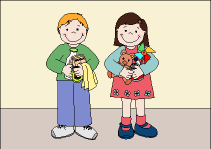 |
Summary of the activity: The children will collect toys, objects, empty medicine bottles. They will do drawings, mold figures with plaster, clay or plasticine for the children in other countries. Objectives: To develop in the children positive emotions when helping the children from other countries. Procedures:
Material Resources: Photos or pictures of volcanoes, storms, etc., toys, empty food and medicine bottles and cases, etc. Color pencils, paper to draw, plaster, mud or clay, color papers, etc.
Development of the activity: He will show pictures and photos of volcanoes or storms, tidal waves, etc. to them (They do not have to be photos that show catastrophic situations which can be traumatic for the children). Later he will suggest the things that the children can bring to help the children from those places.
2nd Part
3rd Part The educator will help all the children to do something, he will demonstrate what to do, if necessary, until everybody produces something. There will be an exhibition with these works which will be titled "For the children in other countries". We will invite the parents and the children from other groups to visit it.
4th Part |
CRITERIAL
ASSESSMENT |
|||
Observed
conduct |
YES |
NO |
Comments |
They
showed interest in completing the task assigned. |
|||
They
showed desires to make something for the children from these towns. |
|||
They
expressed positive emotions and feelings on what they did. |
|||
They
tried to bring objects to help the children from other countries. |
|||
They
cooperated in the assembly and in the exhibition expressing solidarity. |
|||
ACTIVITY
No 4 |
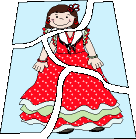 |
Summary of the activity: This activity consists of putting together a jigsaw puzzle. The figures portrayed are allegorical of the cultures of other countries of the world. Objectives: To consolidate the knowledge on people, objects and landscapes from other countries, with which the children are already familiar with from previous activities. Procedures: Material Resources: Several puzzles which the educator can make from pictures and pages from magazines of which he will cut in several pieces (4 or 5 at the most) and will stick to a cardboard so that it is easier for children to manipulate them.
Development of the activity: In addition, he will explain that the winners will be the children who manage to do more puzzles and name what country do the objects or people who appear in them belong to. He will put on the tables several simple puzzles for the children to piece together. The puzzles will have representations of people dressed in typical clothes from their country, typical dresses, goods, landscapes, etc. from other countries (which they have seen in previous activities).
2nd Part |
ACTIVITY
No 5 |
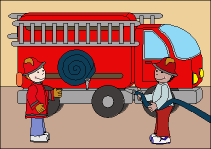 |
Summary of the activity: This is a visit to the fire brigade to learn about its activities, its teamwork. To talk with the men who work as fire-fighters to learn what they do. Objectives: That the children know the supportive attitude of men who risk their lives for others. Procedures: Material Resources: Pictures or photos of fire-fighters rescuing people, extinguishing fires, etc., a fire-fighter’s outfit, toys that represent equipment and accessories that the fire-fighters use to develop their work. We will place them in a play corner.
Development of the activity:
2nd Part
3rd Part
4th Part The children will be invited to take part in a role play with the argument: The fire-fighters work. The children will get dressed up as fire-fighters and will have available for the game some toy equipments and materials that the firemen use. |
CRITERIAL
ASSESSMENT |
|||
Observed
conduct |
YES |
NO |
Comments |
During
and after the visit they showed interest in the feats of these men
and women. |
|||
They
linked the knowledge acquired in the visit to their free games. |
|||
In
other activities or games they talked about the supportive attitude
of the fire-fighters or expressed some clear ideas on the matter. |
|||
They
only expressed some vague notion on the supportive attitude of these
men and women. |
|||
ACTIVITY
No 6 |
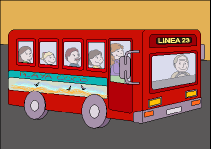 |
Summary of the activity: To complete the block of activities, the educator can run an activity to place the children in a special situation to evaluate those aspects of the block that need to be verified. Objectives: To verify if the children have acquired any knowledge about how and why they have to act in solidarity with other people. Procedures:
Material
Resources:
Development of the activity: Once the children are organized the educator will tell them: -"We are on a bus full of people, what would you do if....”? •
At the next bus stop a grandmother gets on and there are no empty
seats left. Once the answer in each of the situations is given, the child will explain why. The educator can modify or change these situations according to what is more pertinent and necessary to work with his group of children. To end the activity the teacher will start a conversation with the children on the answers given by them in each of the situations and will summarize explaining the correct attitude in each case and why. This situation will serve as a general tool to evaluate this block of activities. |
CRITERIAL
ASSESSMENT |
|||
Observed
conduct |
YES |
NO |
Comments |
They
have enriched their notions on solidarity. |
|||
They
knew how to explain what supportive conducts are. |
|||
They
only have some notions on solidarity. |
|||
The
answers given to the presented situations show they know how and why
to act in a supportive way with other people. |
|||
They
needed much help to be able to explain what is the correct behaviour
in each situation. |
|||
They acted in a supportive way during the game. |
|||


